Evaluating Ionospheric Total Electron Content (TEC) Variations as Precursors to Seismic Activity: Insights from the 2024 Noto Peninsula and Nichinan Earthquakes of Japan
Abstract
1. Introduction
2. Materials and Methods
3. Results and Discussions
3.1. Anomaly of 7 December 2023
3.2. Anomaly of 8 December 2023
4. Conclusions
Author Contributions
Funding
Institutional Review Board Statement
Informed Consent Statement
Data Availability Statement
Acknowledgments
Conflicts of Interest
Appendix A. Space Weather Conditions
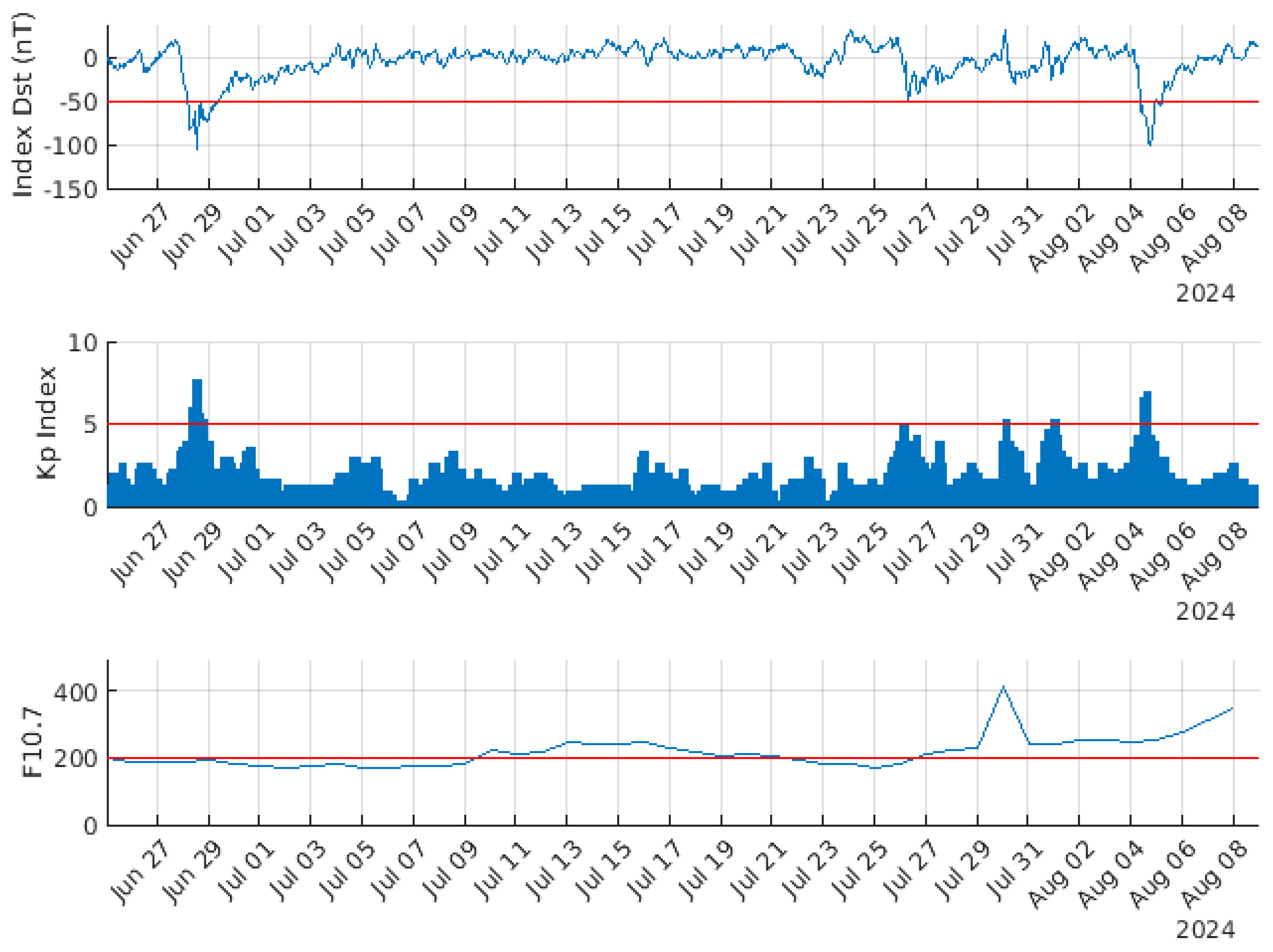
References
- Pulinets, S. Ionospheric precursors of earthquakes; recent advances in theory and practical applications. Terr. Atmos. Ocean. Sci. 2004, 15, 413–436. [Google Scholar] [CrossRef]
- Shah, M.; Jin, S. Statistical characteristics of seismo-ionospheric GPS TEC disturbances prior to global Mw ≥ 5.0 earthquakes (1998–2014). J. Geodyn. 2015, 92, 42–49. [Google Scholar] [CrossRef]
- Chetia, T.; Sharma, G.; Dey, C.; Raju, P.L. Multi-parametric approach for earthquake precursor detection in Assam valley (Eastern Himalaya, India) using satellite and ground observation data. Geotectonics 2020, 54, 83–96. [Google Scholar] [CrossRef]
- Sharma, G.; Saikia, P.; Walia, D.; Banerjee, P.; Raju, P.L.N. TEC anomalies assessment for earthquakes precursors in North-Eastern India and adjoining region using GPS data acquired during 2012–2018. Quat. Int. 2021, 575, 120–129. [Google Scholar] [CrossRef]
- Pulinets, S.; Ouzounov, D. Lithosphere–Atmosphere–Ionosphere Coupling (LAIC) model–An unified concept for earthquake precursors validation. J. Asian Earth Sci. 2011, 41, 371–382. [Google Scholar] [CrossRef]
- Pulinets, S.; Ouzounov, D.; Karelin, A.; Davidenko, D. Lithosphere–atmosphere–ionosphere–magnetosphere coupling—A concept for pre-earthquake signals generation. In Pre-Earthquake Processes: A Multidisciplinary Approach to Earthquake Prediction Studies; Wiley: Hoboken, NJ, USA, 2018; pp. 77–98. [Google Scholar] [CrossRef]
- Li, W.; Sun, Z.; Chen, T.; Yan, Z.; Ma, Z.; Cai, C.; He, Z.; Luo, J.; Wang, S. Atmospheric Charge Separation Mechanism Due to Gas Release from the Crust before an Earthquake. Appl. Sci. 2024, 14, 245. [Google Scholar] [CrossRef]
- Freund, F.T.; Takeuchi, A.; Lau, B.W.; Post, R.; Keefner, J.; Mellon, J.; Al-Manaseer, A. Stress-induced changes in the electrical conductivity of igneous rocks and the generation of ground currents. Terr. Atmos. Ocean. Sci. 2004, 15, 437–468. [Google Scholar] [CrossRef]
- Wang, J.H. Piezoelectricity as a mechanism on generation of electromagnetic precursors before earthquakes. Geophys. J. Int. 2021, 224, 682–700. [Google Scholar] [CrossRef]
- Romero-Andrade, R.; Trejo-Soto, M.E.; Nayak, K.; Hernández-Andrade, D.; Bojorquez-Pacheco, N. Lineament analysis as a seismic precursor: The El Mayor Cucapah earthquake of April 4, 2010 (MW7. 2), Baja California, Mexico. Geod. Geodyn. 2023, 14, 121–129. [Google Scholar] [CrossRef]
- Liu, J.Y.; Tsai, H.F.; Jung, T.K. Total electron content obtained by using the global positioning system. Terr. Atmos. Ocean. Sci. 1996, 7, 107–117. [Google Scholar] [CrossRef]
- Liu, J.Y.; Chen, Y.I.; Chuo, Y.J.; Tsai, H.F. Variations of ionospheric total electron content during the Chi-Chi earthquake. Geophys. Res. Lett. 2001, 28, 1383–1386. [Google Scholar] [CrossRef]
- Liu, J.Y.; Chen, Y.I.; Pulinets, S.A.; Tsai, Y.B.; Chuo, Y.J. Seismo-ionospheric signatures prior to M ≥ 6.0 Taiwan earthquakes. Geophys. Res. Lett. 2000, 27, 3113–3116. [Google Scholar] [CrossRef]
- Zhao, B.; Wang, M.; Yu, T.; Wan, W.; Lei, J.; Liu, L.; Ning, B. Is an unusual large enhancement of ionospheric electron density linked with the 2008 great Wenchuan earthquake? J. Geophys. Res. Space Phys. 2008, 113, A11304. [Google Scholar] [CrossRef]
- Heki, K. Ionospheric electron enhancement preceding the 2011 Tohoku-Oki earthquake. Geophys. Res. Lett. 2011, 38, L17312. [Google Scholar] [CrossRef]
- Heki, K.; Enomoto, Y. Preseismic ionospheric electron enhancements revisited. J. Geophys. Res. Space Phys. 2013, 118, 6618–6626. [Google Scholar] [CrossRef]
- Akhoondzadeh, M. Support vector machines for TEC seismo-ionospheric anomalies detection. Ann. Geophys. 2013, 31, 173–186. [Google Scholar] [CrossRef]
- Melgarejo-Morales, A.; Vazquez-Becerra, G.E.; Millan-Almaraz, J.R.; Martinez-Felix, C.A.; Shah, M. Applying support vector machine (SVM) using GPS-TEC and Space Weather parameters to distinguish ionospheric disturbances possibly related to earthquakes. Adv. Space Res. 2023, 72, 4420–4434. [Google Scholar] [CrossRef]
- Mokhamad Nur Cahyadi, Kosuke Heki, Coseismic ionospheric disturbance of the large strike-slip earthquakes in North Sumatra in 2012: Mw dependence of the disturbance amplitudes. Geophys. J. Int. 2015, 200, 116–129. [CrossRef]
- Akyol, A.A.; Arikan, O.; Arikan, F. A machine learning-based detection of earthquake precursors using ionospheric data. Radio. Sci. 2020, 55, e2019RS006931. [Google Scholar] [CrossRef]
- Tsai, T.C.; Jhuang, H.K.; Ho, Y.Y.; Lee, L.C.; Su, W.C.; Hung, S.L.; Kuo, C.L. Deep learning of detecting ionospheric precursors associated with M ≥ 6.0 earthquakes in Taiwan. Earth Space Sci. 2022, 9, e2022EA002289. [Google Scholar] [CrossRef]
- Nayak, K.; López-Urías, C.; Romero-Andrade, R.; Sharma, G.; Guzmán-Acevedo, G.M.; Trejo-Soto, M.E. Ionospheric Total Electron Content (TEC) Anomalies as Earthquake Precursors: Unveiling the Geophysical Connection Leading to the 2023 Moroccan 6.8 Mw Earthquake. Geosciences 2023, 13, 319. [Google Scholar] [CrossRef]
- Sharma, G.; Mohanty, S.; Kannaujiya, S. Ionospheric TEC modelling for earthquakes precursors from GNSS data. Quat. Int. 2017, 462, 65–74. [Google Scholar] [CrossRef]
- Pulinets, S.; Krankowski, A.; Hernandez-Pajares, M.; Marra, S.; Cherniak, I.; Zakharenkova, I.; Budnikov, P. Ionosphere Sounding for Pre-seismic anomalies identification (INSPIRE): Results of the project and Perspectives for the short-term earthquake forecast. Front. Earth Sci. 2021, 9, 610193. [Google Scholar] [CrossRef]
- Nayak, K.; Romero-Andrade, R.; Sharma, G.; Zavala, J.L.C.; Urias, C.L.; Trejo Soto, M.E.; Aggarwal, S.P. A combined approach using b-value and ionospheric GPS-TEC for large earthquake precursor detection: A case study for the Colima earthquake of 7.7 Mw, Mexico. Acta Geod. Geophys. 2023, 58, 515–538. [Google Scholar] [CrossRef]
- Sharma, G.; Soubam, M.; Walia, D.; Nishant, N.; Sarma, K.K.; Raju, P.L.N. Development of a monitoring system for ionospheric TEC variability before the earthquakes. Appl. Comput. Geosci. 2021, 9, 100052. [Google Scholar] [CrossRef]
- Dai, H.; Huang, G.; Zeng, H. Multi-objective optimal dispatch strategy for power systems with Spatio-temporal distribution of air pollutants. Sustain. Cities Soc. 2023, 98, 104801. [Google Scholar] [CrossRef]
- She, Y.; Li, J.; Lyu, X.; Guo, H.; Qin, M.; Xie, X.; Hu, J. Current status of model predictions of volatile organic compounds and impacts on surface ozone predictions during summer in China. Atmos. Chem. Phys. 2024, 24, 219–233. [Google Scholar] [CrossRef]
- Serguei, B. The Source of Earthquake Energy on the West Coast of Japan 1.1.2024. Magmatic Ram as an Earthquake Generator. Available online: https://ssrn.com/abstract=4685378 (accessed on 5 January 2024).
- Richard, S.; Pagani, M. The GEM Global Active Faults Database. Earthq. Spectra 2020, 36, 160–180. [Google Scholar]
- Dobrovolsky, I.P.; Zubkov, S.I.; Miachkin, V.I. Estimation of the size of earthquake preparation zones. Pure Appl. Geophys. 1979, 117, 1025–1044. [Google Scholar] [CrossRef]
- Blewitt, G. An automatic editing algorithm for GPS data. Geophys. Res. Lett. 1990, 17, 199–202. [Google Scholar] [CrossRef]
- Kersley, L.; Malan, D.; Pryse, S.E.; Cander, L.R.; Bamford, R.A.; Belehaki, A.; Leitinger, R.; Radicella, S.M.; Mitchell, C.N.; Spencer, P.S. Total electron content—A key parameterin propagation: Measurement and usein ionospheric imaging. Ann. Geophys. 2004, 47, 1067–1091. [Google Scholar] [CrossRef]
- Norsuzila, Y.; Abdullah, M.; Ismail, M. Leveling Process of Total Electron Content (TEC) Using Malaysian Global Positioning System (GPS) Data. Am. J. Eng. Appl. Sci. 2008, 1, 223–229. [Google Scholar]
- Sharma, G.; Nayak, K.; Romero-Andrade, R.; Aslam, M.M.; Sarma, K.K.; Aggarwal, S.P. low ionosphere density above the earthquake epicentre region of Mw 7.2, El Mayor–Cucapah earthquake evident from dense CORS data. J. Indian Soc. Remote Sens. 2024, 52, 543–555. [Google Scholar] [CrossRef]
- Nayak, K.; Urias, C.L.; Romero Andrade, R.; Sharma, G.; Soto, M.E.T. Analysis of Seismo-Ionospheric Irregularities Using the Available PRNs vTEC from the Closest Epicentral cGPS Stations for Large Earthquakes. Environ. Sci. Proc. 2024, 27, 24. [Google Scholar] [CrossRef]
- Kumar, S.; Singh, A.K. Ionospheric precursors observed in TEC due to earthquake of Tamenglong on 3 January 2016. Curr. Sci. 2017, 113, 795–801. [Google Scholar] [CrossRef]
- Andreeva, E.S.; Franke, S.J.; Yeh, K.C.; Kunitsyn, V.E. Some features of the equatorial anomaly revealed by ionospheric tomography. Geophys. Res. Lett. 2000, 27, 2465–2468. [Google Scholar] [CrossRef]
- Jonah, O.F.; De Paula, E.R.; Kherani, E.A.; Dutra, S.L.G.; Paes, R.R. Atmospheric and ionospheric response to sudden stratospheric warming of January 2013. J. Geophys. Res. Space Phys. 2014, 119, 4973–4980. [Google Scholar] [CrossRef]
- López-Urias, C.; Vazquez-Becerra, G.E.; Nayak, K.; López-Montes, R. Analysis of Ionospheric Disturbances during X-Class Solar Flares (2021–2022) Using GNSS Data and Wavelet Analysis. Remote Sens. 2023, 15, 4626. [Google Scholar] [CrossRef]
- Urias, C.L.; Nayak, K.; Becerra, G.E.V.; Montes, R.L. An Analysis of Ionospheric Conditions during Intense Geomagnetic Storms (Dst ≤− 100 nt) in the Period 2011–2018. Environ. Sci. Proc. 2023, 27, 18. [Google Scholar] [CrossRef]
- Feng, J.; Zhang, Y.; Li, W.; Han, B.; Zhao, Z.; Zhang, T.; Huang, R. Analysis of ionospheric TEC response to solar and geomagnetic activities at different solar activity stages. Adv. Space Res. 2023, 71, 2225–2239. [Google Scholar] [CrossRef]
- Shreedevi, P.; Choudhary, R.; Thampi, S.V.; Yadav, S.; Pant, T.; Yu, Y.; Sinha, A. Geomagnetic storm-induced plasma density enhancements in the southern polar ionospheric region: A comparative study using St. Patrick’s Day storms of 2013 and 2015. Space Weather 2020, 18, e2019SW002383. [Google Scholar] [CrossRef]
- Oljira, A. A study of Solar Flares and Geomagnetic Storms Impact on Total Electron Content Over High-Latitude Region During July-November 2021: The Case of Tromso Station. Adv. Space Res. 2023, 72, 3868–3881. [Google Scholar] [CrossRef]
- Akhoondzadeh, M. Investigation of the LAIC mechanism of the Haiti earthquake (August 14, 2021) using CSES-01 satellite observations and other earthquake precursors. Adv. Space Res. 2024, 73, 672–684. [Google Scholar] [CrossRef]
- Mizuno, A.; Kao, M.; Umeno, K. A capacitive coupling model between the ionosphere and a fault layer in the crust with supercritical water. Int. J. Plasma Environ. Sci. Technol. 2024, 18, e01003. [Google Scholar]
- St-Laurent, F.; Derr, J.S.; Freund, F.T. Earthquake lights and the stress-activation of positive hole charge carriers in rocks. Phys. Chem. Earth Parts A/B/C 2006, 31, 305–312. [Google Scholar] [CrossRef]
- Bishop, J.R. Piezoelectric effects in quartz-rich rocks. Tectonophysics 1981, 77, 297–321. [Google Scholar] [CrossRef]
- Yasuoka, Y.; Kawada, Y.; Nagahama, H.; Omori, Y.; Ishikawa, T.; Tokonami, S.; Shinogi, M. Preseismic changes in atmospheric radon concentration and crustal strain. Phys. Chem. Earth Parts A/B/C 2009, 34, 431–434. [Google Scholar] [CrossRef]
- Oliver, M.A.; Webster, R. Kriging: A method of interpolation for geographical information systems. Int. J. Geogr. Inf. Syst. 1990, 4, 313–332. [Google Scholar] [CrossRef]
- Myers, D.E. Interpolation and estimation with spatially located data. Chemom. Intell. Lab. Syst. 1991, 11, 209–228. [Google Scholar] [CrossRef]
- Yamazaki, Y.; Häusler, K.; Wild, J.A. Day-to-day variability of midlatitude ionospheric currents due to magnetospheric and lower atmospheric forcing. J. Geophys. Res. Space Phys. 2016, 121, 7067–7086. [Google Scholar] [CrossRef]


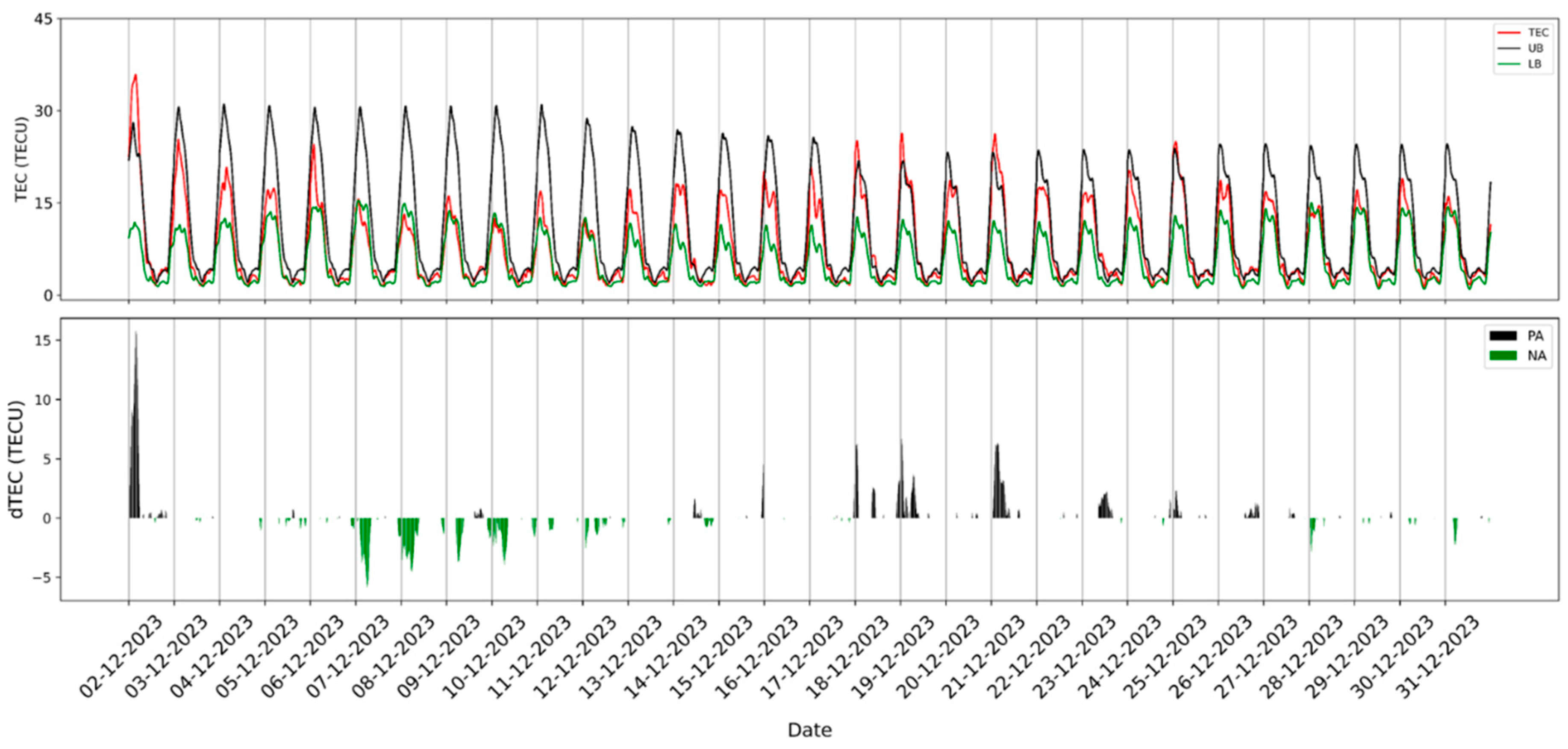
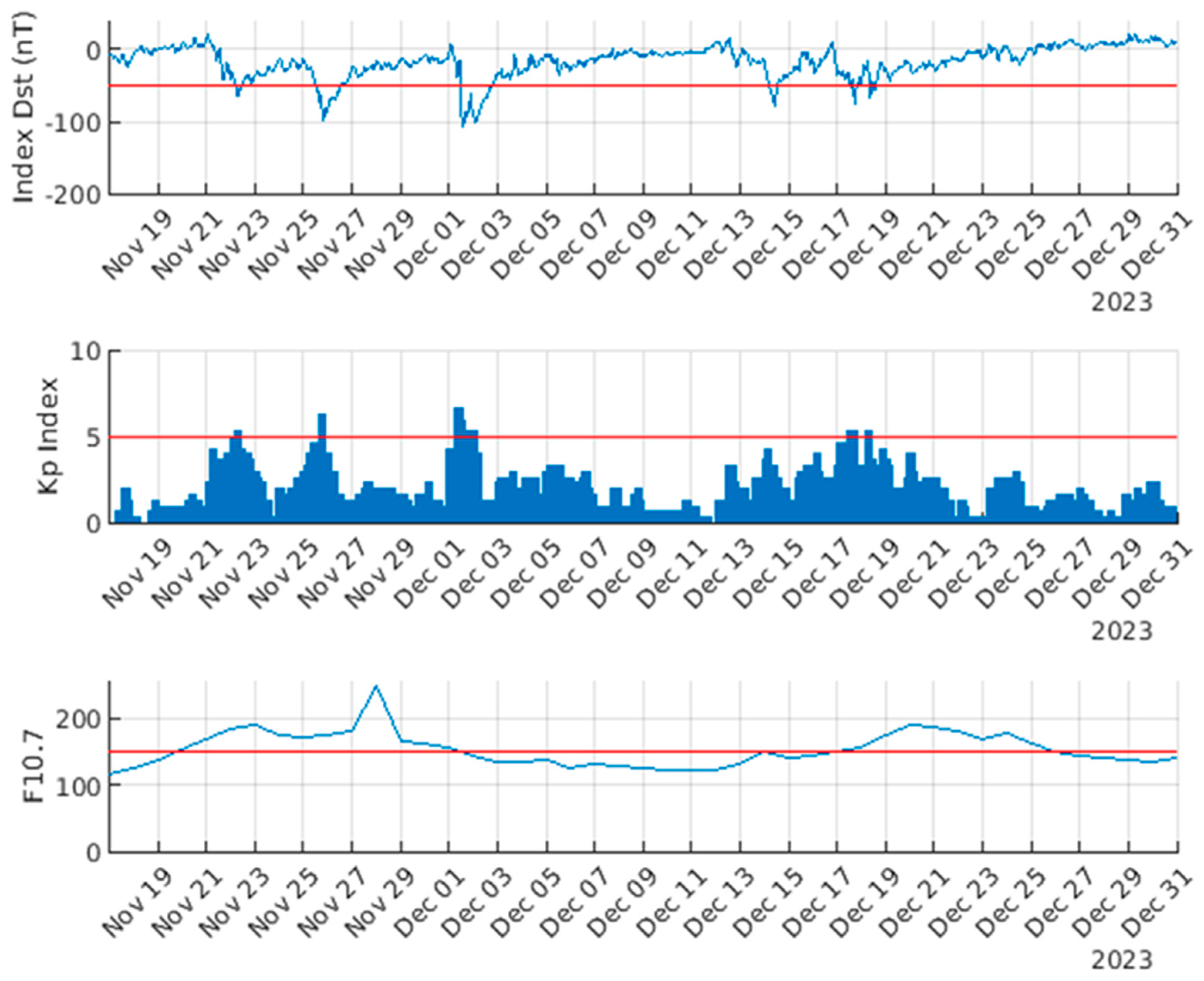


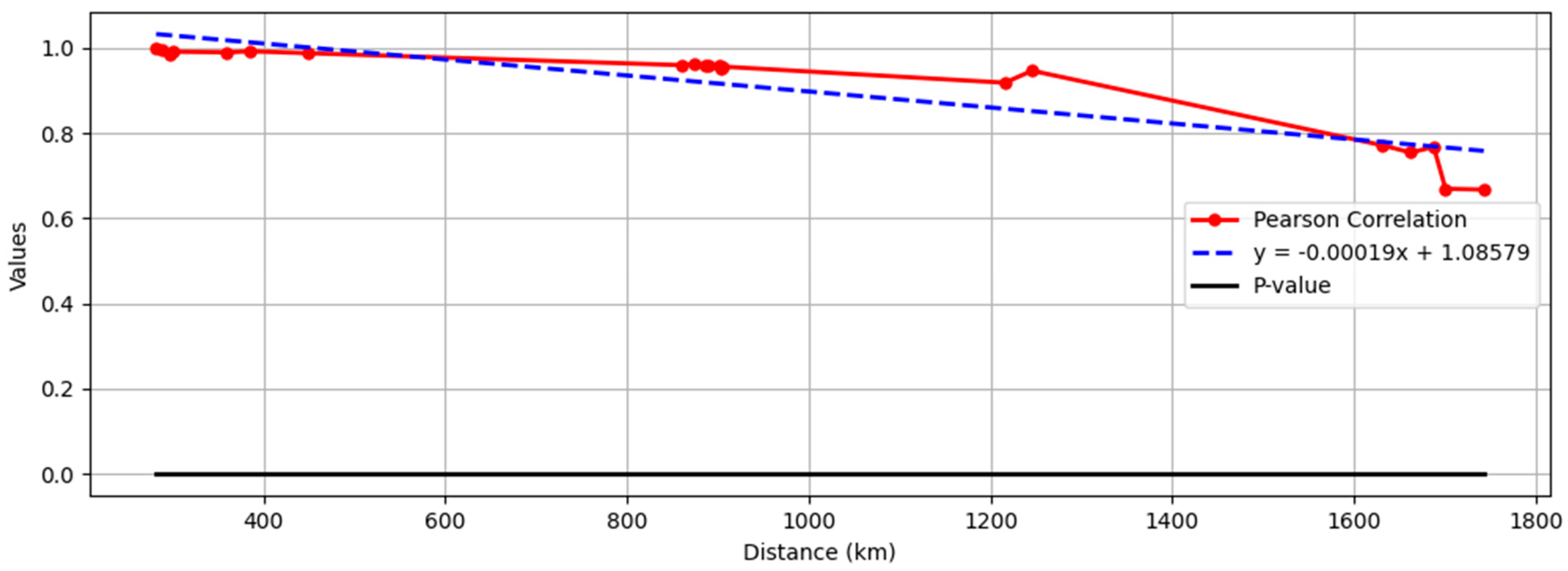
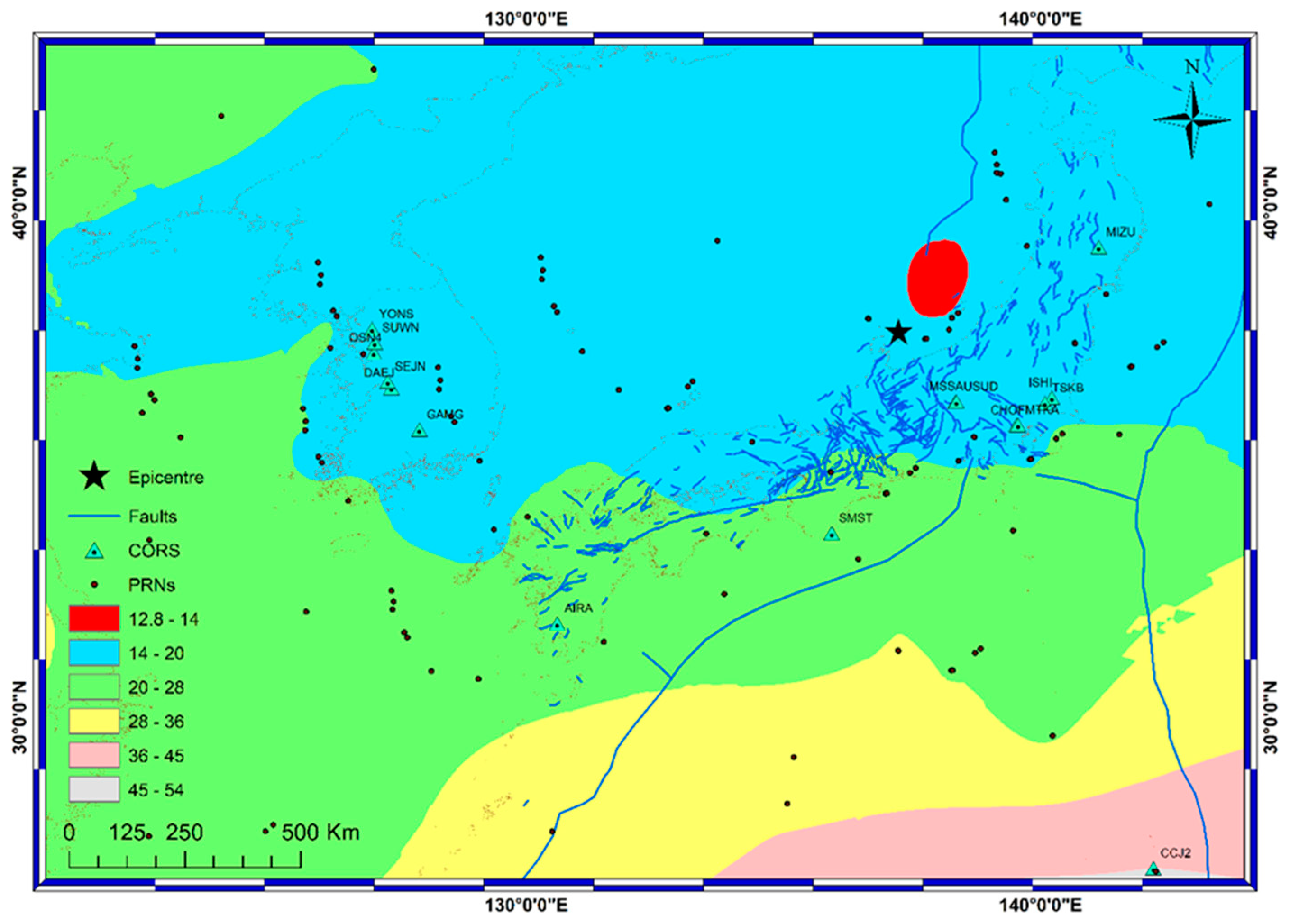
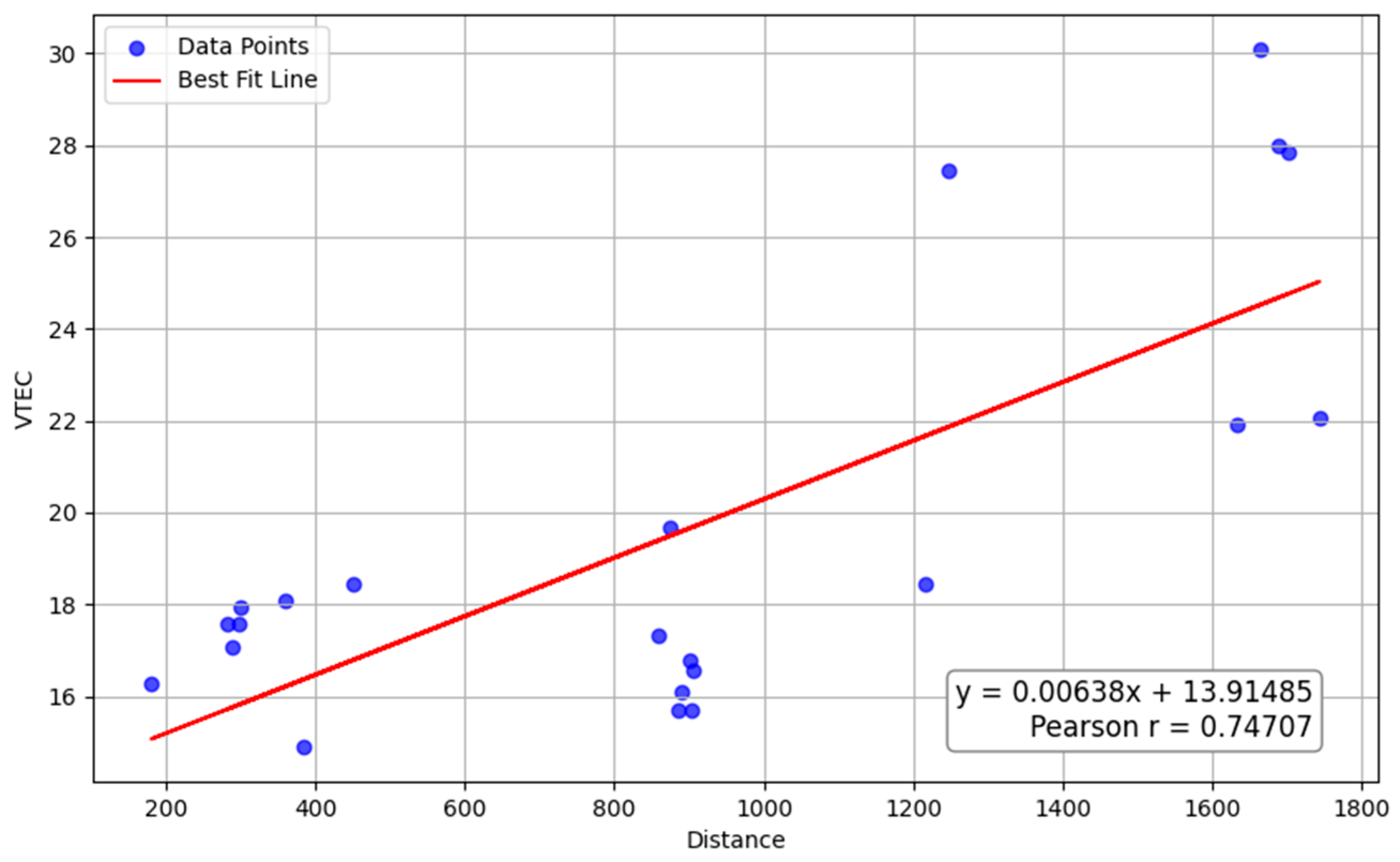


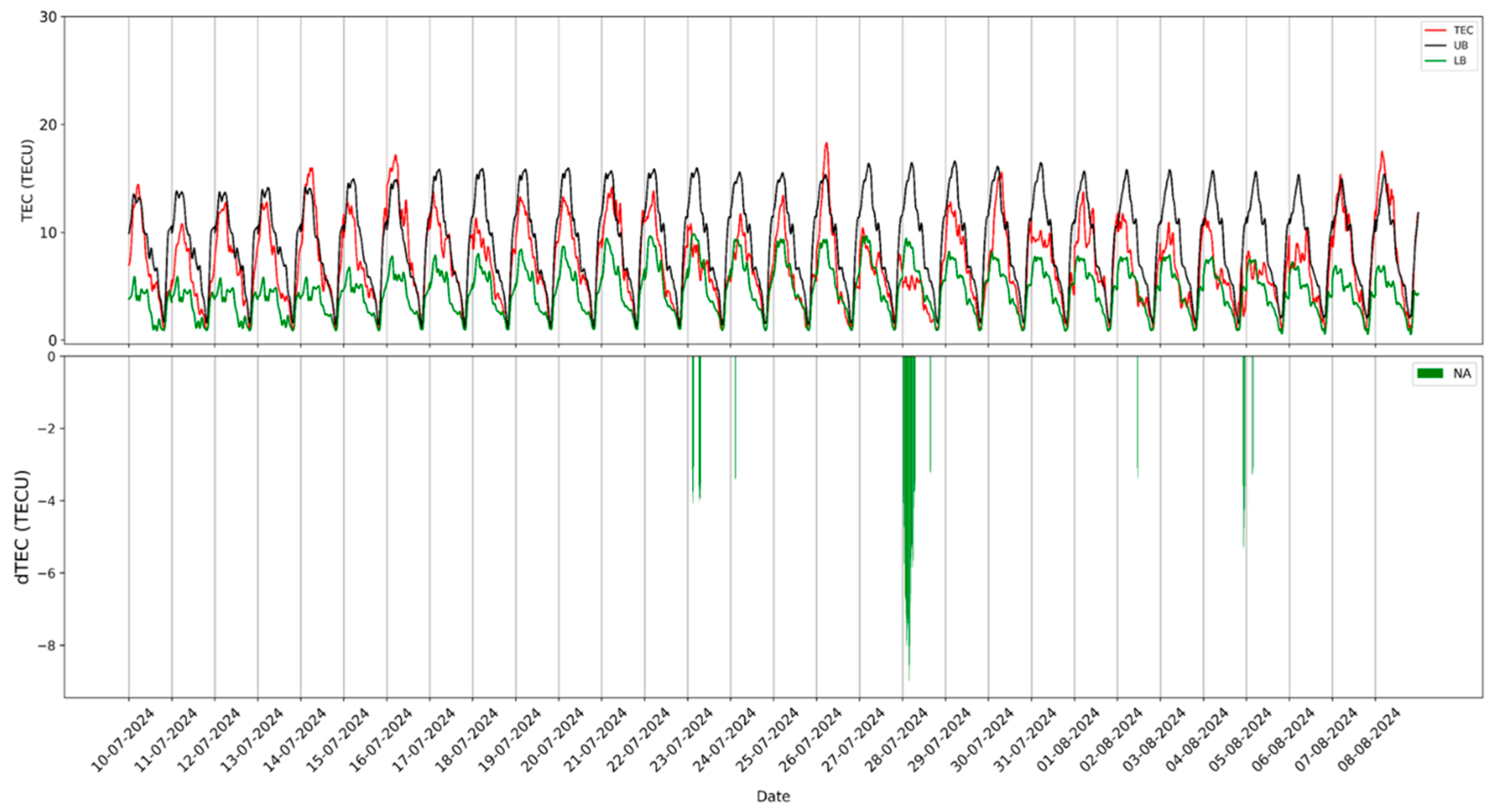
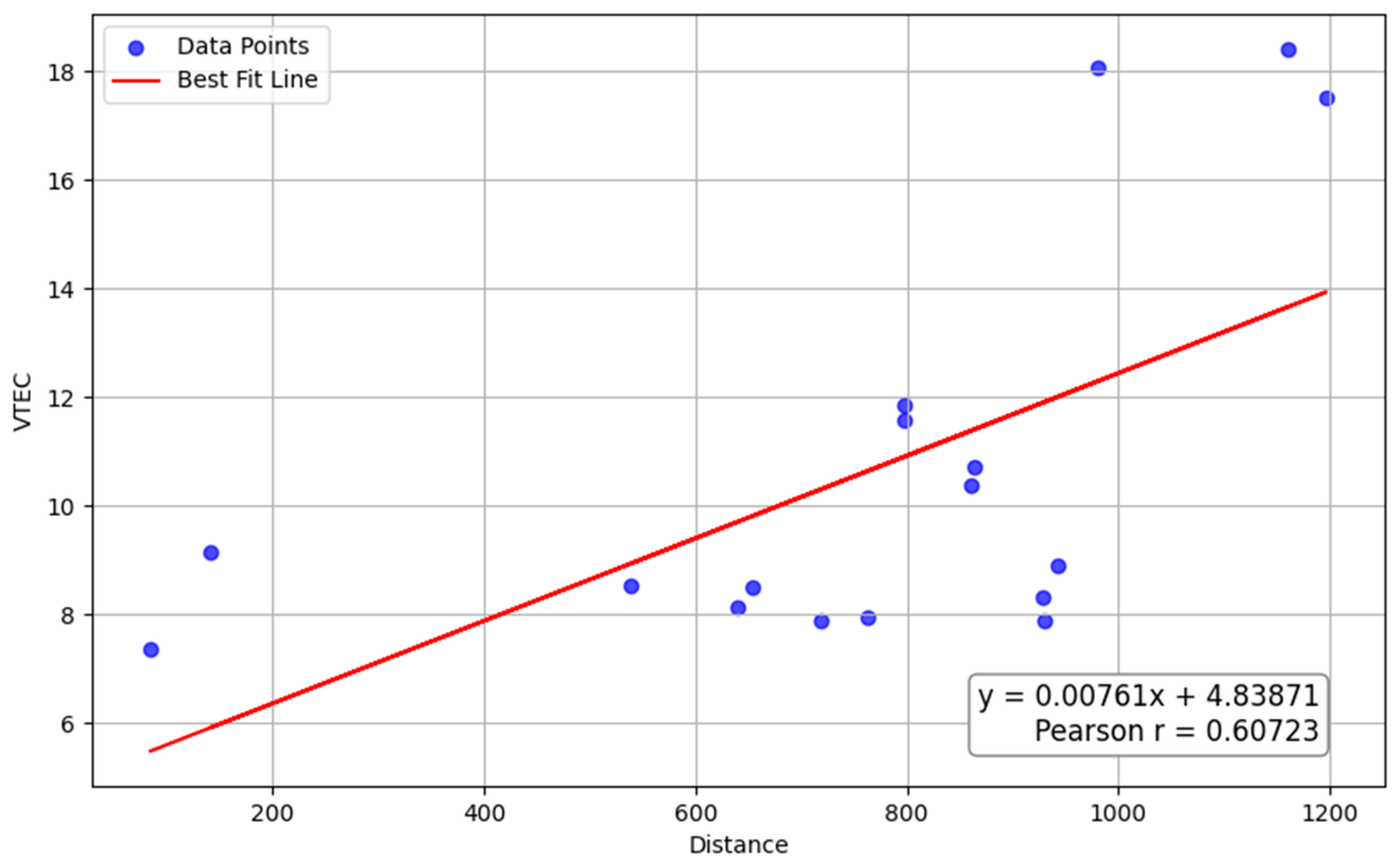
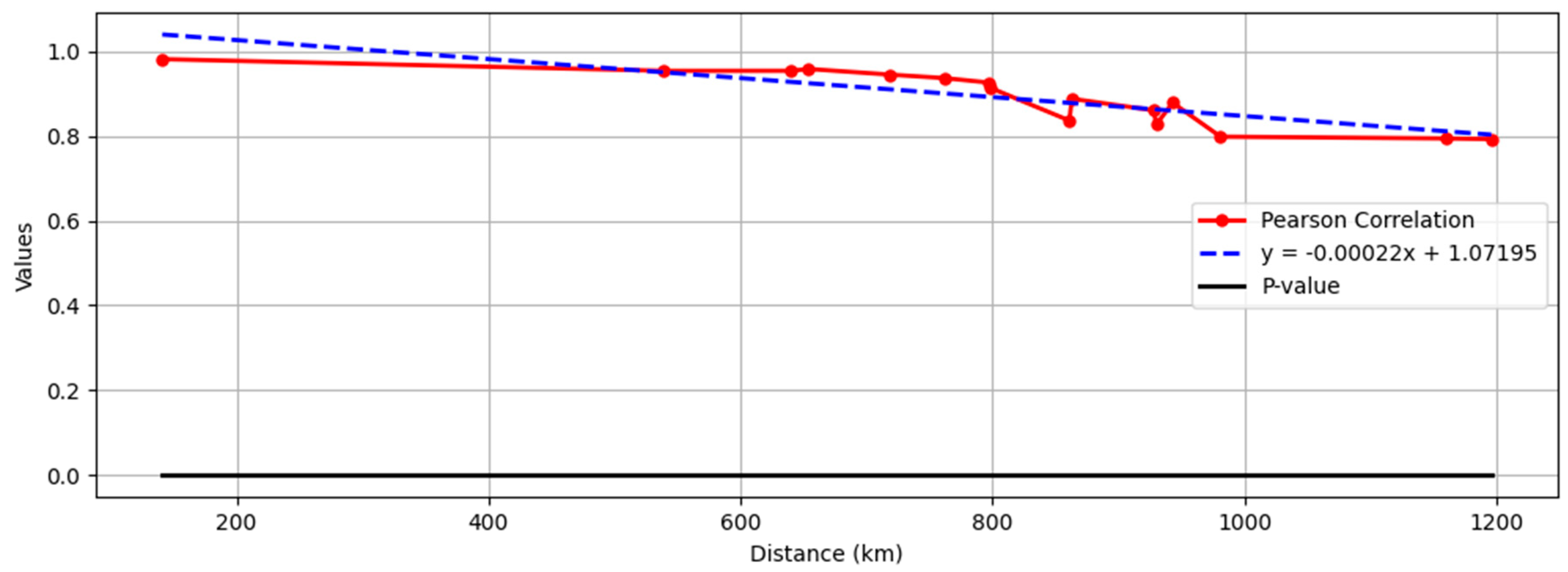

| Station | Lat | Long | Dist. (km) | Station | Lat | Long | Dist. (km) |
|---|---|---|---|---|---|---|---|
| AIRA | 31.824 | 130.6 | 875 | MTKA | 35.68 | 139.561 | 289 |
| CCJ2 | 27.068 | 142.195 | 1246 | OSN4 | 37.083 | 127.034 | 905 |
| CHAN | 43.791 | 125.443 | 1216 | SEJN | 36.522 | 127.303 | 890 |
| KGNI | 35.675 | 139.531 | 282 | SMST | 33.578 | 135.937 | 450 |
| DAEJ | 36.399 | 127.374 | 886 | SUWN | 37.276 | 127.054 | 902 |
| GAMG | 35.59 | 127.92 | 860 | TNML | 24.798 | 120.987 | 1688 |
| ISHI | 36.209 | 140.219 | 301 | TSKB | 36.106 | 140.087 | 297 |
| JFNG | 30.516 | 114.491 | 1632 | TWTF | 24.954 | 121.165 | 1663 |
| KMNM | 24.464 | 118.389 | 1701 | USUD | 36.133 | 138.362 | 181 |
| MIZU | 39.135 | 141.133 | 385 | WUHN | 30.532 | 114.357 | 1743 |
| MSSA | 36.14 | 138.352 | 360 | YONS | 37.541 | 127.001 | 904 |
Disclaimer/Publisher’s Note: The statements, opinions and data contained in all publications are solely those of the individual author(s) and contributor(s) and not of MDPI and/or the editor(s). MDPI and/or the editor(s) disclaim responsibility for any injury to people or property resulting from any ideas, methods, instructions or products referred to in the content. |
© 2024 by the authors. Licensee MDPI, Basel, Switzerland. This article is an open access article distributed under the terms and conditions of the Creative Commons Attribution (CC BY) license (https://creativecommons.org/licenses/by/4.0/).
Share and Cite
Nayak, K.; Romero-Andrade, R.; Sharma, G.; López-Urías, C.; Trejo-Soto, M.E.; Vidal-Vega, A.I. Evaluating Ionospheric Total Electron Content (TEC) Variations as Precursors to Seismic Activity: Insights from the 2024 Noto Peninsula and Nichinan Earthquakes of Japan. Atmosphere 2024, 15, 1492. https://doi.org/10.3390/atmos15121492
Nayak K, Romero-Andrade R, Sharma G, López-Urías C, Trejo-Soto ME, Vidal-Vega AI. Evaluating Ionospheric Total Electron Content (TEC) Variations as Precursors to Seismic Activity: Insights from the 2024 Noto Peninsula and Nichinan Earthquakes of Japan. Atmosphere. 2024; 15(12):1492. https://doi.org/10.3390/atmos15121492
Chicago/Turabian StyleNayak, Karan, Rosendo Romero-Andrade, Gopal Sharma, Charbeth López-Urías, Manuel Edwiges Trejo-Soto, and Ana Isela Vidal-Vega. 2024. "Evaluating Ionospheric Total Electron Content (TEC) Variations as Precursors to Seismic Activity: Insights from the 2024 Noto Peninsula and Nichinan Earthquakes of Japan" Atmosphere 15, no. 12: 1492. https://doi.org/10.3390/atmos15121492
APA StyleNayak, K., Romero-Andrade, R., Sharma, G., López-Urías, C., Trejo-Soto, M. E., & Vidal-Vega, A. I. (2024). Evaluating Ionospheric Total Electron Content (TEC) Variations as Precursors to Seismic Activity: Insights from the 2024 Noto Peninsula and Nichinan Earthquakes of Japan. Atmosphere, 15(12), 1492. https://doi.org/10.3390/atmos15121492








